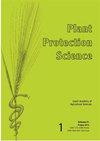Management of Chili Root Rot Pathogen, Rhizoctonia solani, with Potential Rhizobacteria
IF 1.7
4区 农林科学
Q2 AGRONOMY
引用次数: 1
Abstract
Chili (Capsicum annuum L.) belongs to the solanaceae family. It is a major vegetable crop grown on a wide scale in Asia. Nearly 20% of Pakistan's total vegetable producing land is utilized for cultivating chili. Various plant pathogens including viruses, fungi, bacteria and nematodes are responsible for causing diseases in chili crop. Among fungal diseases, root rot is an important fungal disease which is caused by Rhizoctonia solani. In the present study, a survey of different localities of Multan district were conducted and plants with prominent root rot symptoms were collected and subjected to characterization. Moreover, the disease incidence and prevalence was calculated in surveyed localities. Highest disease incidence i.e. 20.77% was evident in samples collected from Tatay Pur and the lowest disease incidence (7.59%) was observed in samples of Suraj Miani. Morphological identification of root rot samples was carried out based on growth, shape, color, and hyphae structure and confirmed the association of R. solani. Koch’s postulates were confirmed after pathogenicity test which was accomplished by stem application method. About 10 rhizobacteria were isolated from rhizospheric soils of healthy plants and dual culture technique was used to manage the R. solani mycelial growth under in vitro conditions. Our results revealed that rhizobacteria 7 (RB7) exhibited the highest inhibition percentage 54.81% while the lowest inhibition percentage i.e. 40% was evident using rhizobacteria 4 (RB4) compared to control. This study helped us to provide the alternatives to the chemical fungicides that could be explored under field conditions against root rot disease as they are ecofriendly and has less impact to the human life.辣椒根腐病病原菌茄枯丝核菌的防治
辣椒(Capsicum annuum L.)属于茄科。它是亚洲广泛种植的一种主要蔬菜作物。巴基斯坦近20%的蔬菜生产用地用于种植辣椒。各种植物病原体,包括病毒、真菌、细菌和线虫,都是辣椒作物致病的原因。在真菌病害中,根腐病是由枯丝核菌引起的一种重要的真菌病害。本研究对木尔坦地区不同地点进行了调查,收集了根腐病症状突出的植物并进行了鉴定。此外,还计算了调查地区的发病率和患病率。塔泰浦尔的发病率最高,为20.77%,苏拉米亚尼的发病率最低,为7.59%。根据根腐病样品的生长、形状、颜色和菌丝结构进行形态鉴定,证实了与茄茄霉的关联。通过茎施法进行致病性试验,证实了科赫的假设。从健康植物根际土壤中分离到10种左右的根瘤菌,采用双重培养技术在体外条件下对茄茄菌菌丝生长进行了控制。结果表明,7号菌(RB7)的抑菌率最高,为54.81%;4号菌(RB4)的抑菌率最低,为40%。该研究有助于我们在田间条件下探索化学杀菌剂防治根腐病的替代方案,因为它们对生态友好,对人类生活的影响较小。
本文章由计算机程序翻译,如有差异,请以英文原文为准。
求助全文
约1分钟内获得全文
求助全文
来源期刊

Plant protection science
Agronomy-PLANT SCIENCES
CiteScore
2.90
自引率
7.70%
发文量
30
审稿时长
12 weeks
期刊介绍:
Original papers, short communications, critical reviews, personal news, and book reviews covering all areas of diseases and pests of plants, weeds and plant protection. Papers are published in English.
 求助内容:
求助内容: 应助结果提醒方式:
应助结果提醒方式:


